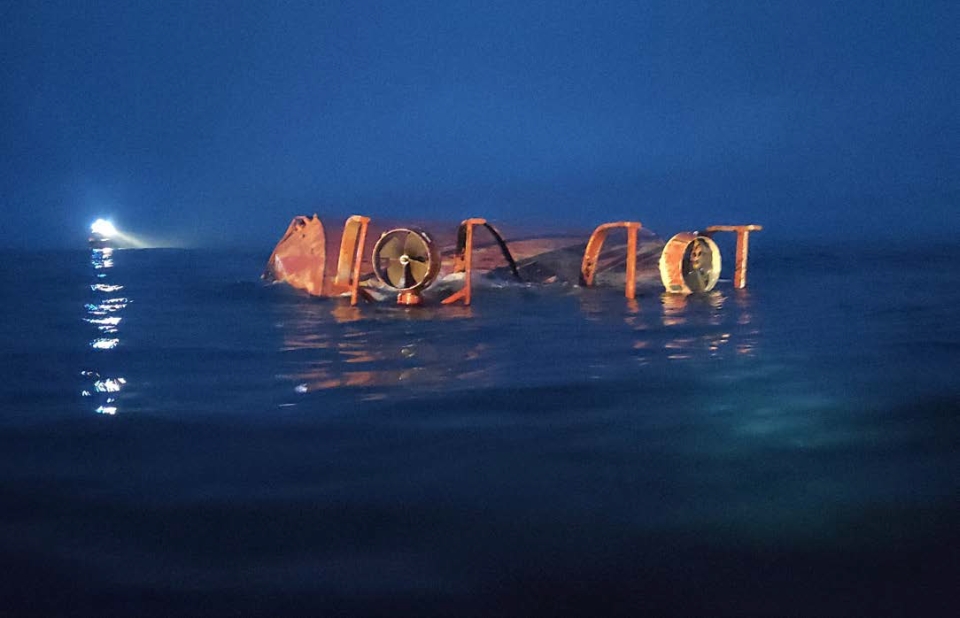At 0327 on 13 December 2021, the UK registered general cargo ship Scot Carrier and the Denmark registered split hopper barge Karin Høj collided resulting in two fatalities. The UK’s Marine Accident Investigation Branch (MAIB) has found neither vessel had a dedicated lookout despite it being dark.
The collision occurred in the precautionary area adjacent to the Bornholmsgat traffic separation scheme, Sweden. As a result of the collision, Karin Høj capsized and its two crew lost their lives.
Scot Carrier struck the hull of Karin Høj at a relative speed of 8.7 knots, causing it to heel to starboard. Scot Carrier’s bulbous bow then lifted Karin Høj’s hull and continued to push it bodily to starboard, reducing its stability and causing it to capsize. This resulted in the death of Karin Høj’s master and presumed death of the mate.
On 16 June 2022, the Courts of Denmark convicted Scot Carrier’s second officer (2/O) of manslaughter and maritime drunkenness. He was sentenced to eighteen months’ imprisonment.
Also read: Vessel capsizes after collision in Baltic Sea
Safety issues
The investigation has revealed the following safety issues:
- The collision occurred after Scot Carrier changed course at a planned waypoint. Neither of the vessels’ watchkeepers identified their converging courses until the collision was inevitable, and the action taken on board Scot Carrier was too late. It is unknown what action was taken by the crew on board Karin Høj.
- The watchkeeper on board Karin Høj had little time to recognise and comprehend the action taken by Scot Carrier, assuming that he was actively monitoring the navigational equipment. Scot Carrier had been overtaking for over an hour and would have been expected to continue to keep clear.
- The 2/O on board Scot Carrier was distracted by using a personal tablet computer and had neither identified the proximity of Karin Høj nor the collision risk following a change of course. On board bridge equipment and watchkeeping systems designed to warn of vessels in proximity were either disabled, unused, or not configured to alert him.
- Both vessels were operating with their watchkeeper as the sole lookout. The posting of an additional lookout on board Karin Høj was not possible as the only crew on board were the two watchkeepers. Scot Carrier routinely operated without a dedicated lookout, and this was normal practice on other ships in the company.
- Rederiet Høj allowed its masters discretion to organise manning and comply with watchkeeping regulations on board their vessels and did not have effective oversight to prevent a vessel from sailing without the statutory number of crew.
- Scot Carrier’s 2/O did not immediately raise the alarm following the collision, which delayed the search and rescue response. However, the speed of capsize and the environmental conditions, would have most likely reduced the survival time of Karin Høj’s crew to a few minutes.
- Although the behaviour of Scot Carrier’s 2/O did not cause the master to suspect he had consumed alcohol before the watch handover, the 2/O had consumed alcohol to a level likely to have affected his judgement.
- Intrada had neither identified that its crews on board Scotline vessels were consistently not posting lookouts during hours of darkness nor that bridge systems were being used ineffectively.
- Alcohol was available on board Scot Carrier yet the company’s policy was ineffective at controlling its consumption at sea.
Also read: Swedish Coast Guard investigates possible intoxication in Baltic Sea collision
‘Watchkeeping is a safety critical task’
‘The collision between Scot Carrier and Karin Høj resulted in the tragic deaths of two seafarers,’ says Chief Inspector of Marine Accidents at the MAIB, Andrew Moll OBE. ‘International requirements are clear that posting an additional person on the bridge as a dedicated lookout is vital to safe navigation. However, this investigation is one of many that have found that the watchkeepers were alone on the bridge at night.’
Moll adds: ‘This report also highlights the dangers of distraction from watchkeeping duties. While shipping companies may have procedures to address distraction, seafarers are also responsible for acting professionally; watchkeeping is a safety critical task. Shipping companies should empower their crews to make the right decisions, highlighting the impact that distraction has on task performance, and have effective methods of ensuring that an additional lookout is posted at night and in poor visibility.’
Also read: Salvage of capsized Karin Høj begins
Recommendations
Scot Carrier’s ship management company has been recommended to review the results of its navigational audits to determine additional training and instruction needs.
Karin Høj’s owners have been recommended to actively monitor its crewing levels so that they are adequately manned at all times.
The Maritime and Coastguard Agency is recommended to advise the shipping industry that the posting of a lookout in addition to a bridge watchkeeper during the hours of darkness and restricted visibility is an absolute requirement in UK waters and on UK ships, and to clarify this in its publications.
Picture by MAIB.








